 W
WThe AGM-62 Walleye is a television-guided glide bomb which was produced by Martin Marietta and used by the United States Armed Forces from the 1960s-1990s. Most had a 250 lb (113 kg) high-explosive warhead; some had a nuclear warhead. The designation of the Walleye as an "air-to-ground missile" is a misnomer, as it is an unpowered bomb with guidance avionics, similar to the more modern GBU-15. The Walleye was superseded by the AGM-65 Maverick.
 W
WThe B28, originally Mark 28, was a thermonuclear bomb carried by U.S. tactical fighter bombers, attack aircraft and bomber aircraft. From 1962 to 1972 under the NATO nuclear weapons sharing program, American B28s also equipped six Europe-based Canadian CF-104 squadrons known as the RCAF Nuclear Strike Force. It was also supplied for delivery by UK-based Royal Air Force Valiant and Canberra aircraft assigned to NATO under the command of SACEUR. In addition, certain U.S. Navy carrier based attack aircraft such as the A3D Skywarrior, A4D Skyhawk, and A3J Vigilante were equipped to carry the B28.
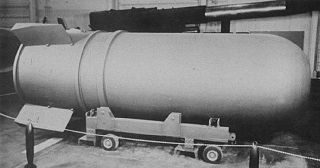 W
WThe B-41 was a thermonuclear weapon deployed by the United States Strategic Air Command in the early 1960s. It was the most powerful nuclear bomb ever developed by the United States, with a maximum yield of 25 megatons of TNT. The B-41 was the only three-stage thermonuclear weapon fielded by the U.S.
 W
WThe B43 was a United States air-dropped variable yield thermonuclear weapon used by a wide variety of fighter bomber and bomber aircraft.
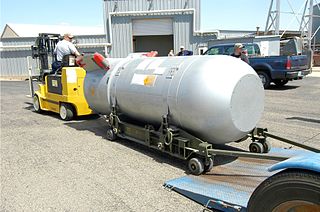 W
WThe Mk/B53 was a high-yield bunker buster thermonuclear weapon developed by the United States during the Cold War. Deployed on Strategic Air Command bombers, the B53, with a yield of 9 megatons, was the most powerful weapon in the U.S. nuclear arsenal after the last B41 nuclear bombs were retired in 1976.
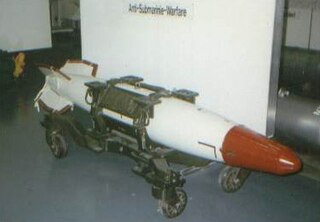 W
WThe B57 nuclear bomb was a tactical nuclear weapon developed by the United States during the Cold War.
 W
WThe B83 is a variable-yield thermonuclear gravity bomb developed by the United States in the late 1970s and entered service in 1983. With a maximum yield of 1.2 megatons, it is the most powerful nuclear weapon in the United States nuclear arsenal. It was designed by Lawrence Livermore National Laboratory.
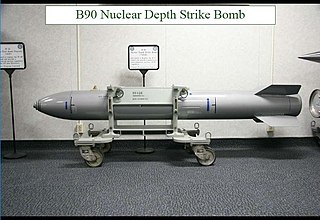 W
WThe B90 Nuclear Depth Strike Bomb (NDSB) was an American thermonuclear bomb designed at Lawrence Livermore National Labs in the mid-to-late 1980s and cancelled prior to introduction into military service due to the end of the Cold War.
 W
WBLU-3 Pineapple was a cluster bomblet, 360 were deployed from the CBU-2A cluster bomb. It was used extensively in the Vietnam War by American forces. It was named "Pineapple" because of its appearance. On some Arc Light missions, the B-52Ds carried two SUU-24 dispensers in the bomb bay, containing a total of 10,656 bomblets.
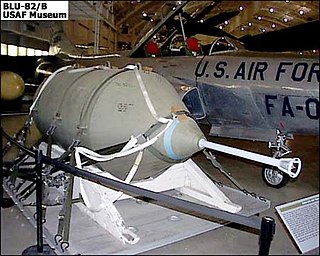 W
WThe BLU-82B/C-130 weapon system, known under program "Commando Vault" and nicknamed "Daisy Cutter" in Vietnam for its ability to flatten a section of forest into a helicopter landing zone, is an American 15,000-pound (6,800 kg) conventional bomb, delivered from either a C-130 or MC-130 transport aircraft or a CH-54 heavy-lift "SkyCrane" helicopter from the 1st Air Cavalry. A total of 225 were constructed. It was successfully used during military operations in Vietnam, the Gulf War and Afghanistan. The BLU-82 was retired in 2008 and replaced with the more powerful GBU-43/B MOAB.
 W
WThe Texas Instruments BOLT-117, retrospectively redesignated as the GBU-1/B was the world's first laser-guided bomb (LGB). It consisted of a standard M117 750-pound (340 kg) bomb case with a KMU-342 laser guidance and control kit. This consisted of a gimballed laser seeker on the front of the bomb and tail and control fins to guide the bomb to the target. The latter used the bang-bang method of control where each control surface was either straight or fully deflected. This was inefficient aerodynamically, but reduced costs and minimized demands on the primitive onboard electronics.
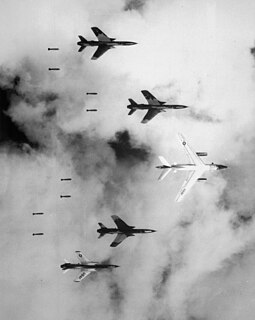 W
WThe American air campaign during the Vietnam War was the largest in military history. The US contribution to this air-war was the largest. Chief of Staff of the United States Air Force Curtis LeMay stated that "we're going to bomb them back into the Stone Age".
 W
WThe CBU-100 Cluster Bomb is an American cluster bomb which is employed primarily in an anti-tank mode. It weighs 222 kg and carries 247 Mk 118 Mod 1 bomblets.
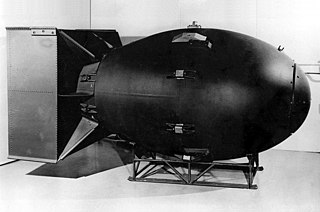 W
W"Fat Man" is the codename for the type of nuclear bomb that was detonated over the Japanese city of Nagasaki by the United States on 9 August 1945. It was the second of the only two nuclear weapons ever used in warfare, the first being Little Boy, and its detonation marked the third nuclear explosion in history. It was built by scientists and engineers at Los Alamos Laboratory using plutonium from the Hanford Site, and it was dropped from the Boeing B-29 Superfortress Bockscar piloted by Major Charles Sweeney.
 W
WThe Rockwell International Guided Bomb Unit 15 is an unpowered glide weapon used to destroy high-value enemy targets. It was designed for use with F-15E Strike Eagle, F-111 'Aardvark' and F-4 Phantom II aircraft. The GBU-15 has long-range maritime anti-ship capability with the B-52 Stratofortress.
 W
WGBU-24 Paveway III or simply GBU-24 is a family of laser-guided bombs, a sub-group of the larger Raytheon Paveway III family of weapons. The Paveway guidance package consists of a seeker package attached to the nose of the weapon, and a wing kit attached to the rear to provide stability and greater range.
 W
WThe Lazy Dog was a small, unguided kinetic projectile used by the U.S. Air Force. It measured about 1.75 inches (44 mm) in length, 0.5 inches (13 mm) in diameter, and weighed about 0.7 ounces (20 g).
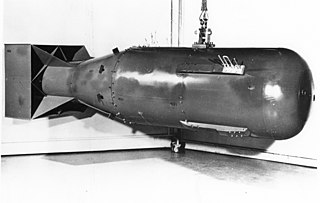 W
W"Little Boy" was the codename for the type of atomic bomb dropped on the Japanese city of Hiroshima on 6 August 1945 during World War II. It was the first nuclear weapon used in warfare. The bomb was dropped by the Boeing B-29 Superfortress Enola Gay piloted by Colonel Paul W. Tibbets, Jr., commander of the 509th Composite Group of the United States Army Air Forces and Captain Robert A. Lewis. It exploded with an energy of approximately 15 kilotons of TNT (63 TJ) and caused widespread death and destruction throughout the city. The Hiroshima bombing was the second man-made nuclear explosion in history, after the Trinity nuclear test.
 W
WThe M117 is an air-dropped demolition bomb used by United States military forces. The weapon dates back to the Korean War of the early 1950s. Although it has a nominal weight of 750 pounds (340 kg) its actual weight, depending on fuze and retardation options, can be around 820 pounds (372 kg). The bomb's explosive content is typically 386 pounds (175 kg) of Tritonal or 377 pounds (171 kg) of Minol in the case of the M117A1E2due to their higher density and detonation velocity compared to TNT. Demolition bombs rely on time delayed fuzes which allow the bomb to burrow into a building or other structure before detonating. The M117 can be configured with a conical low-drag tail for medium and high altitude deliveries or a high-drag tail fin for low-altitude drops, delaying the bombs hitting their targets ensuring fighters are out of the blast zone before detonation.
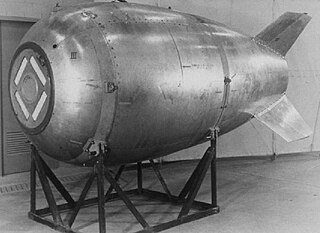 W
WThe Mark 4 nuclear bomb was an American implosion-type nuclear bomb based on the earlier Mark 3 Fat Man design, used in the Trinity test and the bombing of Nagasaki. With the Mark 3 needing each individual component to be hand-assembled by only highly trained technicians under closely controlled conditions, the purpose of the Mark 4 was to produce an atomic weapon as a practical piece of ordnance. The Mark 4 Mod 0 entered the stockpile starting March 19, 1949 and was in use until 1953. With over 500 units procured, the Mark 4 was the first mass-produced nuclear weapon.
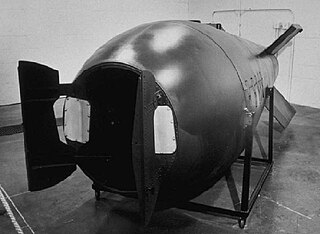 W
WThe Mark 5 nuclear bomb and W5 nuclear warhead were a common core American nuclear weapon design, designed in the early 1950s and which saw service from 1952 to 1963.
 W
WThe Mark 6 nuclear bomb was an American nuclear bomb based on the earlier Mark 4 nuclear bomb and its predecessor, the Mark 3 Fat Man nuclear bomb design.
 W
WMark 7 "Thor" was the first tactical fission bomb adopted by US armed forces. It was also the first weapon to be delivered using the toss method with the help of the low-altitude bombing system (LABS). The weapon was tested in Operation Buster-Jangle. To facilitate external carry by fighter-bomber aircraft, Mark 7 was fitted with retractable stabilizer fins. The Mark 7 warhead (W7) also formed the basis of the 30.5 inches (775 mm) BOAR rocket, the Mark 90 Betty nuclear depth charge, MGR-1 Honest John rocket, and MGM-5 Corporal ballistic missile. It was also supplied for delivery by Royal Air Force Canberra aircraft assigned to NATO in Germany under the command of SACEUR. This was done under the auspices of Project E, an agreement between the United States and the UK on the RAF carriage of US nuclear weapons. In UK use it was designated 1,650 lb. H.E. M.C. The Mark 7 was in service from 1952 to 1967(8) with 1700–1800 having been built.
 W
WThe Mark 8 nuclear bomb was an American nuclear bomb, designed in the late 1940s and early 1950s, which was in service from 1952 to 1957.
 W
WThe Mark 11 nuclear bomb was an American nuclear bomb developed from the earlier Mark 8 nuclear bomb in the mid-1950s. Like the Mark 8, the Mark 11 was an earth-penetrating weapon, also known as a nuclear bunker buster bomb.
 W
WThe Mark-12 nuclear bomb was a lightweight nuclear bomb designed and manufactured by the United States which was built starting in 1954 and which saw service from then until 1962.
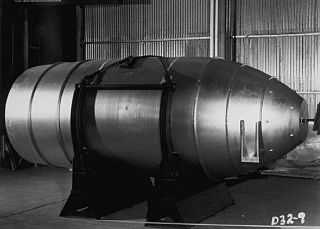 W
WThe Mark 14 nuclear bomb was a 1950s strategic thermonuclear weapon, the first solid-fuel staged hydrogen bomb. It was an experimental design, and only five units were produced in early 1954. It was tested in April 1954 during the Castle Union nuclear test and had a yield of 6.9 Mt. The bomb is often listed as the TX-14 or EC-14. It has also been referred to as the "Alarm Clock" device though it has nothing to do with the design by the same name proposed earlier by Edward Teller and known as the Sloika in the Soviet Union.
 W
WThe Mark 15 nuclear bomb, or Mk-15, was a 1950s American thermonuclear bomb, the first relatively lightweight thermonuclear bomb created by the United States.
 W
WThe Mark 17 and Mark 24 were the first mass-produced hydrogen bombs deployed by the United States. The two differed in their "primary" stages. They entered service in 1954, and were phased out by 1957.
 W
WThe Mark 18 nuclear bomb, also known as the SOB or Super Oralloy Bomb, was an American nuclear bomb design which was the highest yield fission bomb produced by the US. The Mark 18 had a design yield of 500 kilotons. Noted nuclear weapon designer Ted Taylor was the lead designer for the Mark 18.
 W
WThe Mark 21 nuclear bomb was a United States thermonuclear gravity bomb first produced in 1955. It was based on the TX 21 "Shrimp" prototype that had been detonated during the Castle Bravo test in March 1954. While most of the Operation Castle tests were intended to evaluate weapons intended for immediate stockpile, or which were already available for use as part of the Emergency Capability Program, Castle Bravo was intended to test a design which would drastically reduce the size and costs of the first generation of air-droppable atomic weapons.
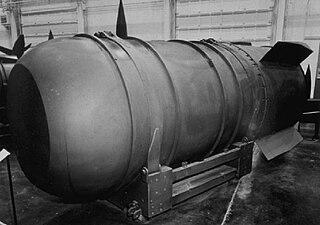 W
WThe Mark 36 was a heavy high-yield United States nuclear bomb designed in the 1950s. It was a thermonuclear bomb, using a multi-stage fusion secondary system to generate yields up to about 19 megatons.
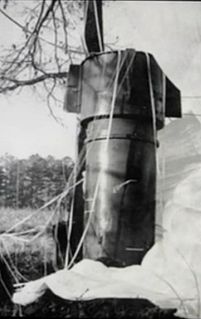 W
WThe Mark 39 nuclear bomb and W39 nuclear warhead were versions of an American thermonuclear weapon, which were in service from 1957 to 1966.
 W
WThe Mark 77 bomb (MK-77) is a United States 750-pound (340 kg) air-dropped incendiary bomb carrying 110 U.S. gallons of a fuel gel mix which is the direct successor to napalm.
 W
WThe Mark 81 250-pound (110 kg) general-purpose bomb is the smallest of the Mark 80 series of low-drag general-purpose bombs.
 W
WThe Mark 83 is part of the Mark 80 series of low-drag general-purpose bombs in United States service.
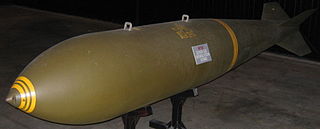 W
WThe M118 is an air-dropped general-purpose or demolition bomb used by United States military forces. It dates back to the time of the Korean War of the early 1950s. Although it has a nominal weight of 3,000 lb (1,350 kg), its actual weight, depending on fuse and retardation options, is somewhat higher. A typical non-retarded configuration has a total weight of 3,049 lb (1,383 kg) with an explosive content of 1,975 lb (895 kg) of tritonal. This is a higher percentage than in the more recent American Mark 80 series bombs thus perhaps the designation as a demolition bomb.
 W
WThe MC-1 bomb was the first U.S. non-clustered air-dropped chemical munition. The 750-pound (340 kg) MC-1 was first produced in 1959 and carried the nerve agent sarin.
 W
WThe T-12 earthquake bomb was developed by the United States from 1944 to 1948 and deployed until the withdrawal of the Convair B-36 Peacemaker bomber aircraft in 1958. It was one of a small class of bombs designed to attack targets invulnerable to conventional "soft" bombs, such as bunkers and viaducts. It achieved this by having an extremely thick, hardened nose section designed to penetrate deeply into hardened concrete structures and then detonate inside the target after a short time delay.
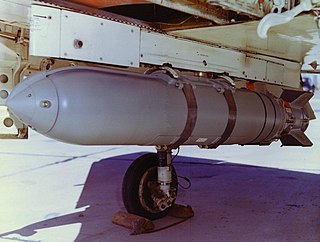 W
WThe Weteye bomb was a U.S. chemical weapon designed for the U.S. Navy and meant to deliver the nerve agent sarin. The Weteye held 160 kg (350 lb) of liquid sarin and was officially known as the Mk 116. Stockpiles of Weteyes were transferred to Utah in the 1980s amidst controversy and protest.